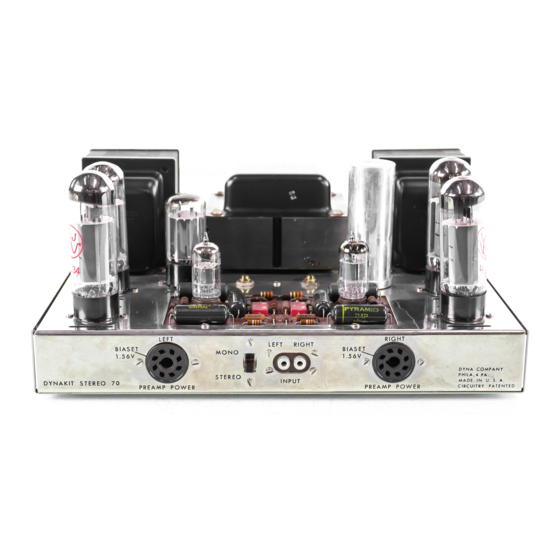DYNACO Stereo 70 Manuale di restauro
Sfoglia online o scarica il pdf Manuale di restauro per Amplificatore DYNACO Stereo 70. DYNACO Stereo 70 20. Series ii tube amplifier
Anche per DYNACO Stereo 70: Manuale di restauro (5 pagine), Manuale d'uso (12 pagine), Istruzioni per il montaggio (16 pagine)

Dynaco Stereo 70 Power Amplifier
Restoration Manual
Detailed Procedure & Guide
Page 1
R0 4-03
I. Introduction
This document provides a step by step instruction for rebuilding and restoring the Dynaco
Stereo-70 power amplifier. It discusses most of the typical and a few atypical problems
that may be encountered with the restoration of the vintage Dynaco Stereo-70 power
amplifier and provides the solution needed to resolve these problems. Most of these
problems are age related and therefore any unit that has not been in service for over six
months should be subjected to the Post Storage Start Up Procedure (Addendum 2). If
your goal is to repair a problem with your Stereo-70 (such as hum, noise, fuse tripping,
etc.) you should review our
available at our
Stereo 70 Troubleshooting Repair Guide
website.
The most problematic components in the Dynaco power amplifiers are (in order of
severity) the Quad electrolytic capacitor, selenium rectifier, output tube sockets, output
tubes, and driver pc board. Of those, it is mandatory to replace the first three since if not
defective they are certain to be soon. In particular, the original Quad electrolytic
st
capacitor, encountering 21
century mains voltages, is operating at or near its design
limits and accordingly is simply unreliable. This is the main reason that we do not
recommend replacing it with another having the same ratings but rather one of the
aftermarket modules that extend the operating voltage and also moderately increase the
energy storage capacity. CAE offers two capacitor modules that meet these objectives
and additionally include a complete new bias circuit (that also replaces the selenium
rectifier). This is essentially a completely new power supply with higher ratings and
energy capacity.
The second most problematic component is the output tube sockets which corrode and
lose conductivity over time. These failures can be very costly since contact failures will
zero bias the output tubes causing the tube to conduct maximum current (you may have
seen the glowing red elements) dramatically shortening the life of the tube (if not
destroying it altogether). Unfortunately the degree of cleaning necessary to remove the
oxidation also removes the nickel plating (preferable to gold) thereby rendering the
cleaning process short lived. The solution is inexpensive - replace the sockets completely
using ceramic based sockets. This is a very worthwhile investment easily paying for itself
considering the cost of premium replacement tubes.
Finally the original Dynaco pc driver board is subject to failure not due to limitations of
the components (although the tube sockets are questionable) but rather due to the
substrate material of the board itself. The majority of the original boards were made from
an inexpensive and common consumer electronics composite phenolic base material. It is
prone to moisture absorption and retention and with the varying temperatures
encountered inside the Stereo-70, has expanded and contracted to the extent that the pc
foil either has or is about to delaminate. This material also becomes coated with grime
that is impossible to remove without harming the board. The symptoms of a defective
drive module are noises, popping and crackling of your amplifier. We realize that many
1
